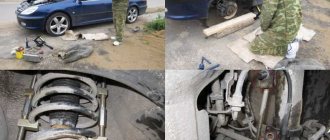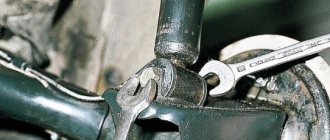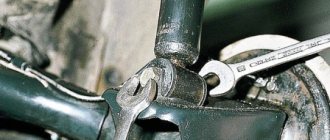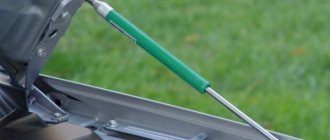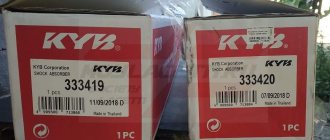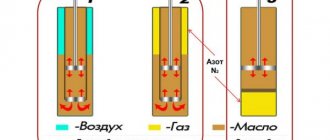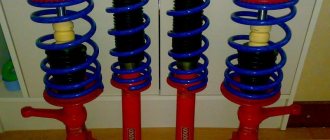Suspension is one of the most important components of any modern vehicle. A self-respecting auto industry will pay special attention to its development. Drivers will agree that it is more pleasant to drive not in a “cart”, but in a car that feels confident on uneven roads.
The suspension system includes parts, assemblies and mechanisms that play a connecting role between the body and the road surface. It performs the important functions of connecting and smoothly turning wheels, eliminating oscillatory forces that arise when interacting with asphalt and soil. The suspension includes elastic elements, guide elements and shock absorbers. It’s worth talking about the last component in more detail, since the problem of failure and repair of shock absorber struts has been and will remain relevant.
Typical shock absorber life
Automotive companies do not announce the exact figure for the period or mileage, after reaching which you can safely go to a car service center with new shock absorbers. If engine oil is changed every 10,000-15,000 km, regardless of the period of its use, then not everything is clear with the suspension elements. The service life depends on operating conditions, the condition of body parts and components, and the design of the chassis. Urban car owners are less likely to encounter problems with suspension malfunctions, while the condition of the dampers of cars driving on rural, unpaved surfaces requires repair or replacement after short periods. According to statistics, when driving on Russian roads, the driver provides the suspension with new shock absorbers that can last an average of 60-80 thousand kilometers, and diagnoses them every 20,000 km.
Cost of replacing racks
Replacement of shock absorber strut 20-50 min 600–1500 rub. Replacing the rear shock absorber strut 20-50 min 600–1200 rub. Replacing the front shock absorber strut 20-50 min 800–1500 rub.
Related suspension services
Suspension diagnostics 15 min - 1 h 0* / 600–1200 rub. Replacing a shock absorber 20-50 min 600–1500 rub. Replacing the shock absorber support 20-50 min 800–1500 rub. Replacing the shock absorber bump stop 20-50 min 600–1500 rub. Replacing the shock absorber spring 30-60 min 600–1500 rub. Replacement of air suspension 30 min - 1 hour 2000–3500 rub. Replacing the air strut 30 min - 1 hour 2000–3500 rub. Replacement of the suspension arm 15-60 min 600–1500 rub. Replacing the boot of the suspension arm joint 20-60 min 400–900 rub. Hub replacement 1-2 hours 800–2000 rub.
How to understand when it's time to change shock absorbers
There are different categories of shock-absorbing elements - gas-oil, gas, oil, and each of them has advantages and disadvantages. If the performance of oil stops depends on temperature, then for gas stops frost is not a problem. In any case, they are all subject to the influence of time and wear, and it is important not to miss the moment the first signs appear. The main mechanism of damper failure is a violation of their tightness and oil leakage. Being under constant high load, a worn out oil seal may not cope with its task, as a result of which gas under pressure evaporates, and trapped air causes the oil to boil. The process develops over time, and at the wrong moment it can present an unpleasant surprise, creating an emergency situation for all road users. How? A driver who has lost traction has to avoid turbulence by constantly steering, which takes a lot of time and effort, and his concentration is lost. The wheels, having lost their connection with the body and with each other, begin to act separately, increasing the braking distance. This means that you need to pay close attention to the condition of the suspension and check its serviceability before each long trip. The performance of shock absorbers is assessed by two methods - a visual method and determination by changes in controllability, stability and stiffness of the suspension.
Visual method
The car is driven under the overpass, carefully inspected and the presence of oil stains on the shock absorber body is detected. To improve the quality of the test, existing stains should be wiped with a rag and reapplied after a few days. If there is no inspection hole or lift, you can dismantle the damper yourself, but such a process will take a lot of time and effort. While under the car, you should pay attention to the following points:
- condition of the shock absorber rods. The presence of corrosion and cracks indicates a partial malfunction and the need for diagnostics
- tire wear pattern. Often, suspension malfunctions lead to uneven wear of the rubber and the appearance of bald spots on the inside of the tire.
- When inspecting the front part, pay attention to the condition of the springs and upper supports. The springs are intact, without cracks or damage, and are considered to be in good condition.
Determining shock absorber malfunction by changes in controllability, stability and suspension stiffness
Suspension disturbances necessarily make themselves felt, changing the vehicle's handling. The driver begins to understand that the steering wheel stops obeying him when performing certain maneuvers, the car “scours” along the road and he has to constantly steer in order to maintain a straight line. When accelerating or making a sharp turn, the car sways like a ship on the ocean caught in a storm.
Performance can be assessed by determining the stiffness of the suspension. We will not burden you with the calculation formulas given in GOST, and will simply say that vertical, longitudinal and lateral stiffness are distinguished. Vertical provides the required smoothness. Knowing the mass per axle of the car and the vibration frequency of the damper, you can determine the vertical stiffness of the suspension. Longitudinal and lateral characterize the degree of comfortable handling, reducing the need for space for wheel arches.
Is it possible to save money when purchasing
Trying to save money on shock absorbers is not a wrong concept, especially if the driver is neat and takes good care of his car. Why not purchase non-original spare parts, especially since the price difference is significant with Chinese products. Of course, manufacturers from China have recently greatly improved the quality of automotive components, but you shouldn’t rely on estimates, it’s better to calculate and check everything.
How often should shock absorbers be changed?
So, let’s take the Japanese brand KYB as the original; one Excel-G shock absorber from this company costs 2.5 thousand rubles, together with the installation of steam it will cost 7 thousand. In defiance, we take the Chinese equivalent for a thousand rubles, a pair will cost 4 thousand. In total, we saved 4 thousand. The service life of Chinese shock absorbers is 25 thousand maximum, that is, in a year and a half they will have to be changed again, and that’s 4 thousand again, plus adjustment and balancing. Japanese is enough for 4.5 years. During this time, 12 thousand will be spent on cheap shock absorbers, plus the cost of adjusting the suspension and balancing.
Is there a way to extend the life of shock absorbers?
The shock absorber body, springs and silent blocks consist of a fairly strong material that cannot always be broken even intentionally. However, time and wear and tear cope with this task with a bang. Hard impacts, bumps, tram rails, low-profile tires, a filled trunk and interior - all this exhausts the capabilities of the resource. Lack of owner maintenance reduces service life. Based on the above, here are recommendations that extend the life of shock absorbers, extracting maximum benefit from them:
- Do not overload the machine. The title of any vehicle indicates the rated capacity and maximum load capacity. You should not exceed these indicators.
- Let it get into working mode. In the frosty season, try to travel the first kilometers at low revs and speed.
- Consider the condition of the roads, the climate of the area, and the average temperature when choosing a particular category of shock absorbers.
- When you see a “road with uneven surface” sign, slow down and try to avoid bumps and speed bumps.
- Do not make sudden or sharp turns, including using the parking brake.
- Do not waste time and money on diagnostics. As they say, the miser pays twice, and it would be unfortunate if the price was life.
RUNNING IN A CIRCLE
First, we will conduct races on standard shock absorbers. Frankly speaking, driving around a racing circuit in a Logan with a 1.4-liter engine producing 75 horsepower is not much fun. While he is accelerating on the straights, you can complete the task in the game “Need for Speed”! And in half of the turns, where sports cars have to be stopped, this Renault doesn’t need to brake at all. However, the car is harmonious and well balanced, even if the lap time is a pensioner’s: 2 minutes 15.4 seconds. In the history of our measurements, the only one slower was the Lada-114, tired from serving in the traffic police, and even then only by one and a half seconds.
201012171556_1
And now the question is: what kind of normal guy would bother to change the shock absorbers on a car simply because, you see, they are old? To be honest, I don't know anyone like that. Perhaps one of those who meekly follows the instructions of the servicemen. But I don’t know that of my own free will, consciously... But I know that even in prosperous Europe, every second elderly car drives with absolutely dead shock absorbers, both in Germany, and in France, and in Italy. And all because, let’s say, it’s really scary to drive without brakes, but with old shock absorbers it’s very possible...
However, no. If the shock absorbers are completely destroyed, then the man becomes uneasy. Even from my first “Zhiguli” I remember how, after a seemingly small bump, the stern of a five-year-old “penny” suddenly began to sway: up - down, up - down... Why two shock absorbers died at once was no longer important, but after replacing them the ride seemed like a thrill. This is, of course, an extreme case. But the same Europeans trumpet at their symposiums that the braking distance of a car traveling at a speed of 80 km/h increases by 2.6 m with half-killed shock absorbers! And if the car is equipped with ABS/ESP systems, then the difference increases up to 5.8 m! Yes, with ABS, a car with damaged shock absorbers begins to brake much worse than without it, no matter how paradoxical it may sound. And if the road is wet, then driving can turn into hydroplaning already at 109 km/h; with normal shock absorbers this would only happen at 125 km/h... And the old shock absorbers are to blame...
QUIET AND QUIET
We move on to braking on smooth asphalt. We rev up the Logan to 105 km/h, turn on neutral and, as soon as the display of the measuring system shows a hundred, we brake to the floor. Moaning the tires briefly in time with the operation of the anti-lock braking system, after the first three brakings the car on standard shock absorbers freezes around the 46.3 meter mark. Then the brakes heat up and the results begin to deteriorate: first by a meter, then by one and a half, two... At the tenth measurement, the Logan froze only after 52.5 meters!
Checking the car on a vibration stand
For the reason that it is not always possible to identify a malfunction on your own or without removing the element, you can contact the service. Here, trained craftsmen will perform it with high professionalism.
How are shock absorber struts checked without removing them from the vehicle?
To do this, you should drive the car onto a special vibration stand. The price of this diagnostic is a thousand or more rubles. This service is also good because not only the strut/shock absorber, but also other elements of the chassis and the brake system are subject to professional inspection. On the vibration stand, road irregularities are simulated, which will allow you to correctly determine the breakdown of a specific mechanism. In addition, this makes it possible to determine the serviceability of bearings (ball and wheel) by checking the lateral rolling of the machine.
The stand has a huge number of sensors that transmit information every second to the main computer.
Vibration test
Advantages of testing with a vibration stand
- the highest accuracy in identifying the slightest faults;
- minimum amount of time.
In addition, owners of freight transport cannot do without this service. Because it is impossible to rock a large car. On a vibration stand it will be possible to establish the problem in its entirety. The only downside is the low prevalence of auto repair shops with similar equipment, even in big cities. In addition, the cost of the service for some car owners can be quite high.
So, we have given several ways to check shock absorbers for malfunctions; you just have to choose the most relevant one for you.
And in order to make driving safe and get by with low repair costs, regularly check not only the shock absorbers, but also other components of your car!
Suspensio20Diagram
Then, as it turned out, both rear shock absorbers “died” at once.
In an era of shortages, this seemed almost a death sentence, but I was lucky: the Zhiguli store in Tekstilshchiki gave me just a couple of the products I needed for a penny - the last ones, by the way. I don’t know the brand of shock absorbers that are in short supply - in those days such questions were simply not asked. Today you can buy KYB, KONI, Monroe, Sachs, Boge, Bilstein - all these are very serious shock absorber brands represented in Russia. And then they were just looking for “shock absorbers for 2101”...
Remembering that incident, I note that obvious signs of refusal were evident. But today it is clear that death did not come instantly: I simply, due to inexperience, did not notice its symptoms. They could be felt both by the behavior of the car and by visual inspection of the shock absorbers.
How does the car's behavior change?
1. Plunging during acceleration and braking
2. Rocking of the car when maneuvering
3. Increased braking distance
4. You have to constantly steer
5. The driver feels tired on previously familiar runs.
External signs of shock absorber failure
1. Wear of the oil seal and rod (leaks)
2. Natural wear and tear of silent blocks
3. Damage to the housing and/or fasteners
Invisible signs of shock absorber failure
1. Changes in the properties of the shock-absorbing fluid (aging, simply put)
2. Wear of the piston seal and the inner walls of the working cylinder
3. Natural deformation of the valve mechanism plates
In other words, shock absorbers wear out gradually, but constantly !
Of course, the most common “popular” way to check the condition of shock absorbers is to rock the car body. But in practice, only two extreme conditions can be determined in this way: the damper is completely out of order or it is jammed. And the resistance of the multi-link suspension elements generally reduces the value of this method to almost zero. It's easier to go to the service station.
no_copyright_101443
Our comment: Mikhail Kolodochkin, head of the ZR examination department
A couple of years ago at the BMW Driving School they taught me... to slow down! Everything seems simple: you need to press the pedal to the floor so that the back of the seat almost crunches. However, the car remains controllable: I still have to go around the obstacle, which is only a few meters away...
One try, ten, thirty... Do you understand everything, dear? Now get into another car: it’s almost fine, only the shock absorbers are half dead. Does not work? Did you knock down the cone again? Don’t be upset: the instructor won’t succeed with such a machine either. The most unpleasant feature of any shock absorbers, in my opinion, is that they die gradually, and not like light bulbs in a headlight. The driver gradually gets used to the fact that the car becomes a little different, blaming everything on the bad road and other external factors. And no one wants to think that a shock absorber is a wear-out product. The list of horror stories is easy to expand. To the failure of the brakes when going around an obstacle and the risk of aquaplaning, I would add the unpredictable frequency of vibrations of the car body - a very unpleasant effect. In addition, the tires will be “offended” and will begin to wear unevenly - the chain reaction will accelerate the wear of the shock absorber, and so on...
kybal_guide_anual1968
A little theory
The speed of movement of the shock absorber rod is up to 4 m/s, and the fluid temperature in them reaches 120 °C. In this case, the gas pressure inside the shock absorber can reach 50 atmospheres. And all this with the number of cycles per kilometer approximately fluctuating in the range of 1500–2500. In terms of 70 thousand km of recommended mileage, this will be approximately 120–200 million cycles.
Note that the shock absorber consists of approximately 70 parts, half of which are valve train components. In order to reduce the cost of its production as much as possible, a number of eastern manufacturers save on each of them. It makes no sense to talk seriously about resource and reliability.

